The Dutch became powerful. Batavia (Jakarta) became their Eastern Capital.
Their aim was to drive the Portuguese out from the east.

1619
Entrenched in Batavia, the attention of the Dutch is in Kerala
The Dutch began advancing, leaving behind the Portuguese in the east. In 1618, they established trade centres in Eastern islands. They constructed in 1619 the city of Batavia on the northern shores of Java (Jakarta) and it was the Eastern government of the Dutch empire headquartered at Batavia that took decisions on trade in the east. The Dutch, thus, became a threat to the Portuguese in Japan and Goa, had known in advance that the British who laid eyes on India with an aim to capture Goa of Portuguese and strengthen trade in Malabar, would become a potential threat to them.
The British too were jealous of the rise of Dutch power. But as the common foes were the Portuguese, they continued to feign as friends. Still at times oblivious of this, they engaged themselves in minor skirmishes. During this period the state of the English was slightly better. As Thomas Roe who came over the court of Jahangir, the Mughal emperor, was a spirited diplomat, he was able to obtain certain concessions whose outcome was that in 1619 factories were opened in Surat, Allahabad, Agra and Broach.

The Zamorin, who has been awaiting the Dutch and the English fleets in Malabar for help thus became frustrated. The two European forces did not come over to confront the Portuguese. But at the same time he had been relentlessly attacked by Cochin which was under the control of the Portuguese. While he had encamped at Kodungallor mobilising forces to fight off Cochin, the Dutch group with Van Den Broecke being the head, came over Cherruvay. Receiving him as a guest and entertaining him for a few days there, the Zamorin requested him to open a factory in his kingdom. The Zamorin might have calculated that the Dutch would have to be there to safeguard the factory once it was erected .Then his discussion centred on pepper trade but no trade agreement was signed. The Dutch had a perception with them that for their smooth trade on the coasts of Malabar, the Portuguese had to be driven out, at any cost, from Goa and so their attempts were aimed at reducing the influence of the Portuguese before paying heed to the request of the host. The British, in the meanwhile, made their presence felt at various parts of India as a third force.
How many castes and customs and modes of nuptials were there! The Namboothiri women going outdoors with unfurled Marakkudas, the indigenous palm frond-woven umbrellas.
Disputations settled through traditional martial combat, the Ankams.

1619
The societal set-up that has evoked curiosity amongst the Dutch
The Dutch concentrated their attention on territories inclusive of Malabar (Keralam) transforming Batavia in Java Islands as the capital of their eastern possessions. Their next aim was to capture Malabar which had been under the subjugation of the Portuguese. The English too did not remain idle. They had been running around to establish more and more trade centres after signing agreements with the Mughal Empire which had been ruling vast territories in India.
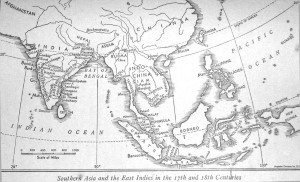
17th and 18th Centuries
The politico-social scenario of Kerala, even after 106 years of the advent of the Portuguese did not change considerably during the arrival of British and the Dutch. Kerala was 'split up in to a number of 'nadus' or principalities each of which was under a local chieftain called 'naduvazhi'. There was no organised central government or law. The naduvazhi had wide and unlimited powers. But the Naduvazhi's rule was checked to a certain extent by the 'tharakkuttams', organised for civil purposes (the local assemblies which have representatives including the Nairs). The main source of income of the naduvazhi was 'chunkam' or customs revenue from imports, exports and transports.
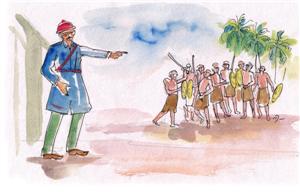
'Madambis', the Nair nobles, helped the naduvazhi's militarily during the period of war. Throughout the land there were, under their supervision Kalaris, where martial arts and the craft of warfare were imparted to youths. Women too were trained at the 'kalaries'. In northern Kerala, Thiyyas too enrolled in army as accepting it as a profession. There existed a practice of resolving disputations between two groups through 'Ankam', a sort of military combat. The affected parties need not be locked horns directly in the combat. Instead paid proxy combatants who were trained in martial art could take on themselves on the condition that the naduvazhi gave permission to do so. The family of the ankam combatant perished in the combat was customarily compensated for. As the society was based upon caste, punitions too were awarded based on it. A person awarded with capital punishment had his body been cut into halves and then hoisted on 'kazhuvu', a type of crossbar.
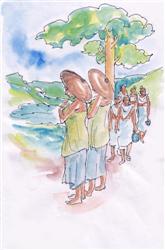
Women were given freedom to a certain extent. But it was compulsory that when Namboothri women went out they should carry 'marakkuda', the traditional palm-woven umbrella, to conceal their faces from public view. The Christian women wore 'muttak' while the Muslim women 'thattam'. The Nair women would wear beautiful and attractive ornaments. At the upper layer of the society, the Brahmins, the priestly class had great influence who even controlled the kings belonging to the Kshatriya caste. Amongst the Brahmins the Namboothiris enjoyed superiority. In Namboothiri families same caste marriage was allowable only to the eldest son. The others in the family were accustomed to have their nuptials called as Sambandam with women belonging to other castes as Khastriyas, Nairs and Ambalavasis. The next in caste hierarchy after the Brahmins was the Nairs. Below them was the Ezhavas being the important non-caste community.
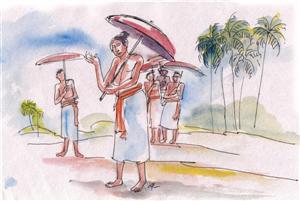
The low-caste people were the Pulayas, Parayas Mukkuvas and so on. Every caste was prescribed a distance of untouchability from the Brahmins who would become an outcaste once the distance was transcended by the non-Brahmins. So, all were wary of keeping the safe distance from the Brahmins.
The low-caste people such as Pulayas and Mannans were given customary permission to kidnap women of higher castes at certain special occassion. This custom of women-lifting was called as 'Pulappedi' and 'Mannappedi'.
The Dutch and then the English landed on the coasts of Kerala when there existed diverse and odd social customs and systems. To the Dutch all of these were curious spectacles.
Shajahan, the Mughal emperor, entwined in familial problematiques.
Charles-1, the king of England confronting civil war.
The English erects fortress in Madras.
The end of Eravikutty Pillai.
The English factory in Vizhinjam.

1619
The English and the Dutch Struggle for Pepper
When the European powers, the Dutch and the English were running around to broaden their trade centres in Asian countries, there took place change of rule in England and India. James-1 in England and Jahangir, the Mughal emperor, passed away in 1625 and in 1627 respectively. The cold war between Charles-1 who came to power consequent on the death of James-1 and the British parliament became bitter. What Shajahan faced in India was familial problematiques. This new scenario helped the Dutch and the English in India to enlarge the number of trade centres. The Portuguese power in India was on the wane. The Dutch had their eyes on the headquarters of their possessions in India, Goa. The Dutch had a foreboding at the export of pepper by the English to England in 1636 from Cochin.
Despite the three-decade long spurt of growth at Cholamandalam since 1630, the Dutch was taken aback, in the meanwhile, by the British when Francis Day, having purchased a place called, Madras for the East India Company and raised a factory on it. They raised big forts around it, naming it later as Fort St. George. This fort became the outer gate of British luck in India.
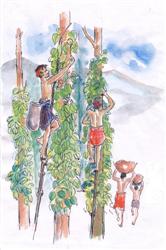
The aim of the Dutch was to crush the supremacy of the Portuguese in the monopoly of pepper trade in Malabar. In 1645, Portuguese was a part of Spain and the decline of the former's power started with it. Much to the frustration of the Dutch, the news of the liberation of Portuguese from the Spanish supremacy in the meanwhile reached India, but the Dutch went ahead with the strategies to capture Goa from the Portuguese. Though the Dutch started eyeing on Goa since 1639, they could not pursue the goal. In the meanwhile their focus of attention shifted to Ceylon (Sri Lanka) and they anticipated that they could crush the trade of Portuguese in India if they were driven out from Ceylon. They were, at the same time, concerned about the chain of events that took place at Venad at the far south of Kerala. It was during this period that the invasion of Thirumala Nayakar of Madura, who became powerful after the sinking of Vijayanagara empire, took place at Venad when Eravikutty Pillai, repulsing the attack, perished (1634). As a result of the invasion of Nayaka, territories in Nanchinad became orphaned. It was during this period that the English East India Company approached Ravi Varma, the king of Venad to erect a factory at Vizhinjam and the factory established at Vizhinjam made the Dutch not sleep a wink.